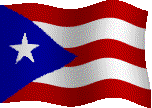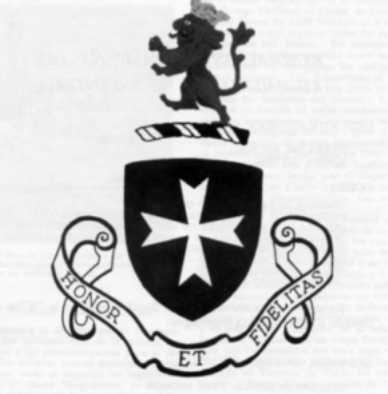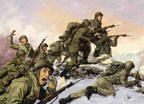 ....... Puerto Rico's ...
....... Puerto Rico's ...
65th Infantry Regiment
U.S. Army

COMMANDS by Colonel Gilberto
Villahermosa
ญญญญญญญญญญญญญญญญญ_________________________________________________________
Designation:
65th Infantry
Regiment
_________________________________________________________
Activation:
4 June 1920
_________________________________________________________
Campaigns:
Naples Foggia, Rome-Arno, Central Europe, Rhineland
_________________________________________________________
The 65th Infantry Regiment was created on 2 March 1899 as the
Puerto Rico Battalion of Volunteer Infantry to assist the U.S. Army in
reestablishing law and order on Puerto Rico following the seizure of the
island in 1898 during the Spanish-American War. The battalion proved so
successful that the following year it was expanded into the Puerto Rico
Regiment of U.S Volunteers and in 1901 became the Puerto Rico Provisional
Regiment of Infantry. On 30 June 1908, the regiment became part of the Regular
Army and was renamed the Puerto Rico Regiment of Infantry United States Army.
During World War I, the regiment guarded vital installations in Puerto Rico
and Panama and also trained the newly formed Puerto Rico National Guard. On 4
June 1920, the unit was designated the 65th Infantry Regiment. The regiment
was manned with Puerto Rican soldiers and sergeants, and led by Puerto Rican
and continental company grade officers and continental field grade officers.
At the beginning of 1941 the strength of the
regiment stood at 125 officers and 2,945 enlisted men. Under a series of
seasoned commanders, like Colonel John Ross Mendenhall, the 65th Infantry
trained intensively for combat in Puerto Rico. A 1915 graduate of West Point,
Mendenhall had served with the 3d Infantry Division’s 7th Machinegun Battalion
during World War I, winning a Silver Star Commendation and a Purple Heart.
Prior to assuming command of the regiment, he had served as an instructor with
the New York National Guard’s 107th Infantry Regiment. In February he and the
65th Infantry participated for the first time in night maneuvers at the
Salinas Maneuver Area and in August and September in Puerto Rico Department
maneuvers. On 7 December, word of the Japanese attack at Pearl Harbor reached
the island and elements of the regiment immediately occupied defensive
positions at the Naval Radio Station and Dry Dock on the island. By then the
strength of the regiment had grown to 131 officers and 2,991 enlisted men.
The 65th Infantry was the first Puerto Rican
unit deployed to Panama to guard the Canal Zone. On 7 January 1943, the
regiment departed San Juan, arriving at
San Cristobal,
the Canal Zone, on 14 January with 153 officers and 3,037 enlisted men. In
Panama the unit became part of the Canal Department’s Mobile Force. The
regiment guarded vital installations and manned observation posts on both the
Atlantic and Pacific sides of Panama. Nor were security missions limited to
Panama alone. On 19 August Companies E and F and the Anti-Tank Company
departed the Canal Zone, arriving at the Galapagos Islands three days later
for temporary duty, relieving elements of the 150th Infantry Regiment. Company
E proceeded on to Salinas, Ecuador, where it arrived on 25 August for
temporary duty. The men of the regiment also participated in other missions.
On 24 October one officer and nine enlisted men of the jungle platoon departed
Panama for a rescue mission in the Cocos Islands. They returned on 6 November
“after having successfully completed their mission.” The battalions of the
65th were continuously rotated through jungle training for visiting student
officers of the Latin American countries. As a result, the regiment attained a
high degree of proficiency in jungle operations and was praised for its
performance. The 65th conducted security missions until December 1943.
The month prior, Colonel Antulio Segarra had
assumed command of the regiment. His appointment was a historical first for
the United States Army, Puerto Rico, and the regiment. Segarra was the first
Puerto Rican Regular Army officer to command a Regular Army regiment. A 1927
West Point graduate and 1942 General Staff College graduate, the 37 year-old
Segarra had commanded the Puerto Rican National Guard’s 296th Infantry
Regiment prior to taking command of the 65th Infantry. His selection to
command the regiment was a distinction extended to few other minority officers
during the entire war. His appointment, along with the deployment of the 65th
overseas, was both a sign of the Army’s growing confidence in its Puerto Rican
officers and soldiers and a reflection of its growing need for infantry in the
combat theaters.
In January the 65th embarked for Jackson
Barracks, New Orleans and then Fort Eustis, Virginia, in preparation for
overseas deployment to North Africa with 146 officers and 3,106 enlisted men.
In Virginia, the men drew new uniforms and equipment and trained. At the
beginning of March, the number of officers increased to 162. An advance party
of the regiment arrived in Casablanca, French Morocco on 16 March and the
remainder of the regiment followed on 5 April. Once overseas the 65th
Infantry was parceled out for security missions. The 3d Battalion was assigned
to the Twelfth Air Force in the Mediterranean Theater of Operations to guard
Army Air Force installations on Corsica. The remainder of the regiment
conducted amphibious training in North Africa and performed security missions.
After the 3d Battalion rejoined the regiment the focus of training was
switched to city fighting. In August, Company C was detached from the 1st
Battalion and flown to France to guard the Seventh Army Command Post.
On 22 September, the 2d and 3d Battalions
also left North Africa for France, where they were assigned to the Seventh
Army. The regiment arrived in Toulon, France on 1 October. By the second week
of December the 1st Battalion was guarding the Sixth Army Group and Seventh
Army Command Posts, as well as fuel depots and railheads. The 2nd Battalion
was assigned to the SOLOC (Southern Line of Communications), guarding trains
transporting war supplies between Marseille and Northern France and around the
coast as far as Nice. The remainder of the regiment, which included 3d
Battalion, the regimental headquarters, the Cannon Company, the Anti-Tank
Company, and the Service Company, was attached to the 44th Anti-Aircraft
Artillery Brigade and stationed on the front line near Peira Cava, where the
regiment held a sector extending from Roquebilliere to Mt. Grosso along the
Franco-Italian border. Their mission was to protect the Sixth Army Group’s
right flank, conduct vigorous patrolling, and provide early warning should the
German Army in Italy attempt to attack into Southern France.
Lieutenant Colonel Juan Cesar Cordero, a
Puerto Rican National Guard officer, commanded the 3d Battalion in combat. The
40-year old officer was a graduate of the University of Puerto Rico and
Mayaguez’s College of Agriculture and Mechanical Arts, where he had received
his Reserve Commission as a second lieutenant. His battalion had relieved the
2nd Battalion of the Japanese-American 442nd “Nisei” Infantry Regiment on 13
December. The 442nd Regimental Combat Team was on the 65th Infantry’s right,
while the 899th Anti-Aircraft Artillery Battalion, fighting as infantry, was
on the left. Facing the regiment was the German 34th Infantry Division’s 107th
Infantry Regiment. During the month the Puerto Ricans participated in a number
of small unit engagements at Turini, Epinal-Chenimenil, and Leintray.
On the night of 15 December 1944, Private
Sergio Sanchez-Sanchez and Sergeant Angel G. Martinez became the first members
of the regiment to die in combat in World War II as a result of a German
assault on Company L. In all, seven men of the regiment were killed during
December in combat, including two officers and a sergeant. Another ten men
were wounded, including two officers and three sergeants. On 4 January 1945,
the regimental commander, Colonel George Almond Ford, was killed leading a
reconnaissance patrol. A West Pointer and former Coast Artillery officer, Ford
had volunteered for service in France and branch transferred to the Infantry.
The 3d Battalion was relieved from the Maritime Alps on 26 February 1945, and
the entire regiment concentrated in Lorraine for further action in southwest
Germany. In March 1945, the 65th crossed the Rhine and remained in Germany as
part of the Army of Occupation until October 1945, when it was ordered to
Calais, France, for the return home. The regiment returned to Puerto Rico on 9
November 1945. Although its service in World War II had been limited, its
soldiers had won a Distinguished Service Cross, two Silver Stars, and 90
Purple Hearts while on the front lines. The 65th was awarded battle
participation credits for the Naples-Foggia, Rome-Arno, Central Europe, and
Rhineland campaigns.
 ....... Puerto Rico's ...
....... Puerto Rico's ...


